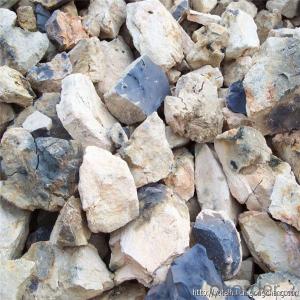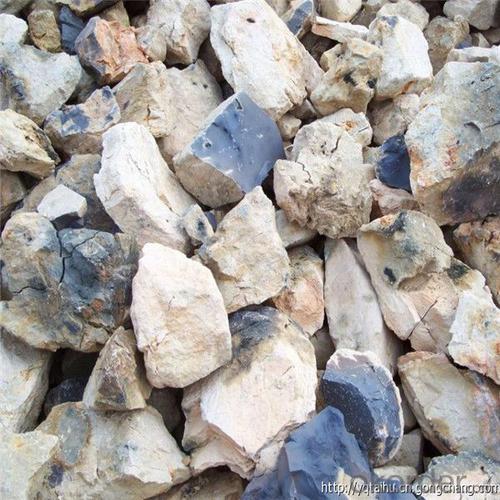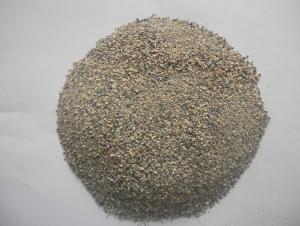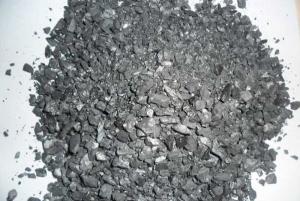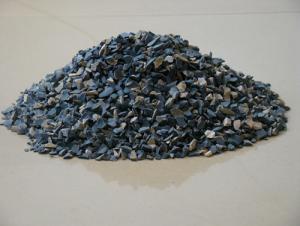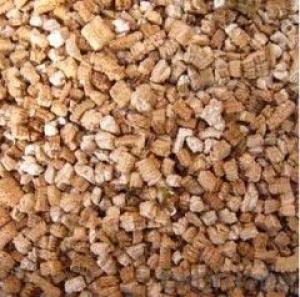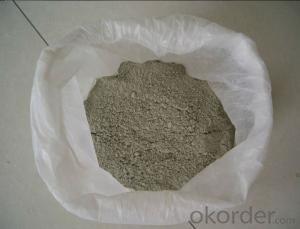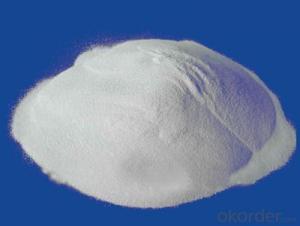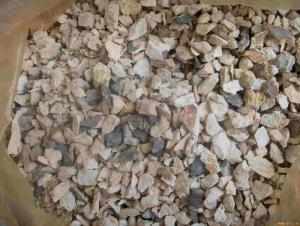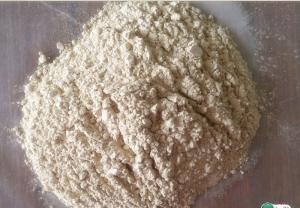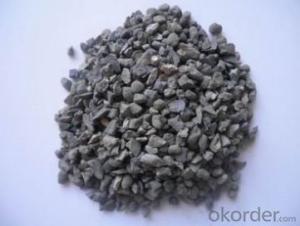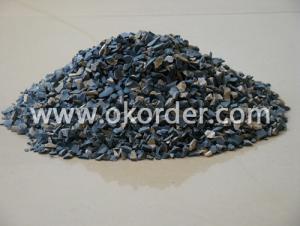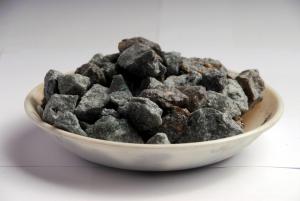Low SiO2 Bauxite Rotary Kiln RKB Raw Materials for Refractory
- Loading Port:
- China Main Port
- Payment Terms:
- TT OR LC
- Min Order Qty:
- -
- Supply Capability:
- -
OKorder Service Pledge
OKorder Financial Service
You Might Also Like
Specification of Calcined Bauxite
Item | Al2O3 (min) | Fe2O3 (max) | TiO2 (max) | SiO2 (max) | KO2+NaO2 (min) | CaO+MgO (min) | Bulk Density(g/cm3) |
70 | 70% | 2.5% |
|
|
|
| 2.9min |
75 | 75% | 3.0% | 4.0% | 8% | 0.3% | 0.6% | 2.7min |
80 | 80% | 3.0% | 4.0% | 8% | 0.3% | 0.6% | 2.8min |
85 | 85% | 2% | 4.0% | 8% | 0.3% | 0.6% | 3.0min |
86 | 86% | 2% | 4.0% | 8% | 0.3% | 0.6% | 3.2min |
87 | 87% | 2% | 4.0% | 7% | 0.3% | 0.6% | 3.2min |
88 | 88% | 1.8% | 4.0% | 7% | 0.25% | 0.6% | 3.25min |
90 | 90% | 1.8% | 4.0% | 7% | 0.25% | 0.6% | 3.25min |
In 1MT jumbo bag or as the buyer request.
We ship the cargo in 20' GP containers,each container loads 25MT/20bags.
Application of Calcined Bauxite
1.aluminium industry
2.precision casting
3 refractory materials
4.aluminum silicate refractory fiber for fiber blanket, refractory brick .
5. refractory cement
Bauxite is an aluminium ore and is the main source of aluminium.
Bauxite is used in cement, chemicals, face makeup, soda cans, dishwashers, siding for houses.
- Q: What is the fire resistance thickness of the thin fire-retardant coatings?
- There is no detailed requirement on the thickness of the thin steelwork fireproof coatings and the thickness there refers to a certain thickness which must(at least) have fire resistance for a certain time. The thickness of fireproof coatings in engineering generally depends on the manufacturer's test reports. Our thin steelwork fireproof coatings: the fire resistance is 2.5 hours, the thickness is 4.9 mm, the fire resistance is 2.0 hours, the thickness is 3.5 mm, the fire resistance is 1.5 hours, the thickness is 1.75 mm, the fire resistance is 1.0 hours, the thickness is 1.17 mm.
- Q: What are grade classifications of the external walls fireproofing material?
- There are many kind of external walls fireproofing material, according to the document No. 65, the grade of external wall fireproofing material can be divided into: Level A is inorganic insulation non-combustible materials, such as cement foam insulation board, vitrified?micro bead?thermal insulation?mortar, rock wool board, glass wool panels. Level B1 is nonflammable material, mostly are organic material which has added a relatively large amount of flame retardant, such as polystyrene board, extruded sheet, phenolic foam board and polyurethane board. Level B2 is flame-retardant materials, and also known as fire-retardant materials, mostly are organic insulation materials with appropriate amount of flame retardant.
- Q: Who knows what is the standard of insulation material whose fire proof is level A?
- Level A is distinct from B in coefficient of fire proofing. Level A is non combustible, while Level B is divided into B1( flame retardant), B2(combustible) and B3( inflammable). Currently in the market, level A materials are as follows: phenolic, rock wool, insulation mortar, ceramic foam, foam glass, and foamed concrete. The most advantageous of level A material at present is foamed concrete, also known as foamed cement. Xuzhou Lvchuang Construction company is working on this, you can search fro it on the internet, it has high cost performance.
- Q: How to distinguish the construction fire-proof material rating?
- Each country has its own fireproof standards, so I do not know which country you are in ? Each country has different division levels of fireproof materials, such as GB 8624, German standard DIN 4102-1, British standard BS 476, France standard NF P92-501 and so on. GB 8624 Chinese building materials and products combustion performance division levels fireproof resources network (FireTC.
- Q: What's the difference between refractory metal raceway and fireproof raceway?
- Refractory metal is used to lay and control cables, while trunking is used to lay wires and communication cables; refractory metal is bigger (200*100-600*200), while trunking is smaller; refractory metal has bigger turning radius, while trunking mostly turns a right angle; refractory metal has larger span, while trunking has smaller span; their fixation and installation ways are also different.
- Q: How to choose thermal insulation materials for flood heating?
- 1, Select the appropriate floor material suitable for radiant floor heating. The floor radiant heating system mainly transfer heat through the ground concrete and the ground material to the room. Therefore in the heating season the ground material will always be heated during heating season. Therefore, it is better to choose stone materials and compround floor plate insensitive to tenmperature change with good heat dissipation and functions. Currently, wood floor is not suitable for the ground radiant heating system. 2, choose the pipe with anti permeability performance. Plastic floor heating pipe itself has a certain air permeability, if oxygen penetrates in it is prone to oxygen erosion and system's mental device will be eroded, resulting in the risk of leakage. Therefore in order to ensure the reliable operation of the heating system, the selected pipe must have anti oxygen permeation performance, and meet the standard stipulated by the DIN4726 oxygen permeation quantity: and be less than 0.1mg\L.d at 40 C.
- Q: What is the particle size of boron carbide for refractories?
- 0.3-0.5% is OK, but also with other additives, such as aluminum powder, silicon powder, magnesium alloy powder and so on. To achieve good results.
- Q: What are the differences between first-level fire-resistant materials and second-level fire-resistant materials?
- The combustion performance of materials could be divided into: A( noninflammability), B1(flame retardancy), B2(flammability), B3(inflammability). Building materials are divided into four ranks according to these properties. 1. In accordance with Code for Design of Building Fire Protection(GBJ16-1987)(revised edition in 2001), fire hazards in producing and storage can be divided into five types. In Fire Prevention Code of Petrol Chemical Enterprise Design(GB50160--1992)(revised edition in 1999), classification of fire hazards is also achieved according to the hazards of materials that have been using, producing and storing. Measures in prevention of fire explosion could be taken from the perspectives of fire separation, fire resistance level of structures, allowable floors, safe evacuation, and fire extinguishing facilities based on different levels of fire hazards. 2. Four fire resistance rating of buildings are listed in the book Code for Design of Building Fire Protection. And specific stipulations are made to the fire resistance of main elements of buildings, such as bearing walls, beams,pillars, and floors. When designing a building, if permitted, refractory materials of high-rank should be adopted in those buildings which have high potential fire hazard and a lot of combustible material and valuable equipment. While making sure fire resistance rating, the duration of fire resistance of each elements should meet its requirements.
- Q: What are the types of refractory sealant?
- Refractory sealant has low exothermicity and will form a hard corking content during burning, it includes: Liquid polysiloxane has at least two active groups selected from alkoxy, hydroxy and alkenyl; a cross-linking agent, a catalyst, a reinforcing filler and wollastonite. These cured silicone rubber sealant has low heat release and will form a hard coking content structure while buring. Refractory sealant composition can be used in sealing structure to prevent flames, air and other steams passing. 1. In a liquid organic polysiloxane polymeters, each R1 is independently selected from the alkyl, aryl, alkenyl and haloalky which has 1-18 carbon atoms, and each R2 is independently selected from the hydroxy, alkoxy, alkenyl, and X is an integer from about 10 to 1,500. 2. A crosslinking silicone compound having at least 3 silicon-bonded eactive groups. 3. A R2 pressed of silicon bonding capable of promoting component A. 4. Wollastonite and a selective reinforcing filler.
- Q: How to distinguish the fire resistant level of construction materials?
- Building materials fire resistant level is divided into four levels, among which the first level is the highest, with strongest fire resistance; fourth level is the lowest with weakest fire resistance. Fire resistance level of buildings depends on combustion performance and fire endurance of the building components. The building components refer to a series of basic components such as the building walls, foundations, beams, columns, floors, stairs, ceiling, etc.
Send your message to us
Low SiO2 Bauxite Rotary Kiln RKB Raw Materials for Refractory
- Loading Port:
- China Main Port
- Payment Terms:
- TT OR LC
- Min Order Qty:
- -
- Supply Capability:
- -
OKorder Service Pledge
OKorder Financial Service
Similar products
Hot products
Hot Searches
Related keywords
